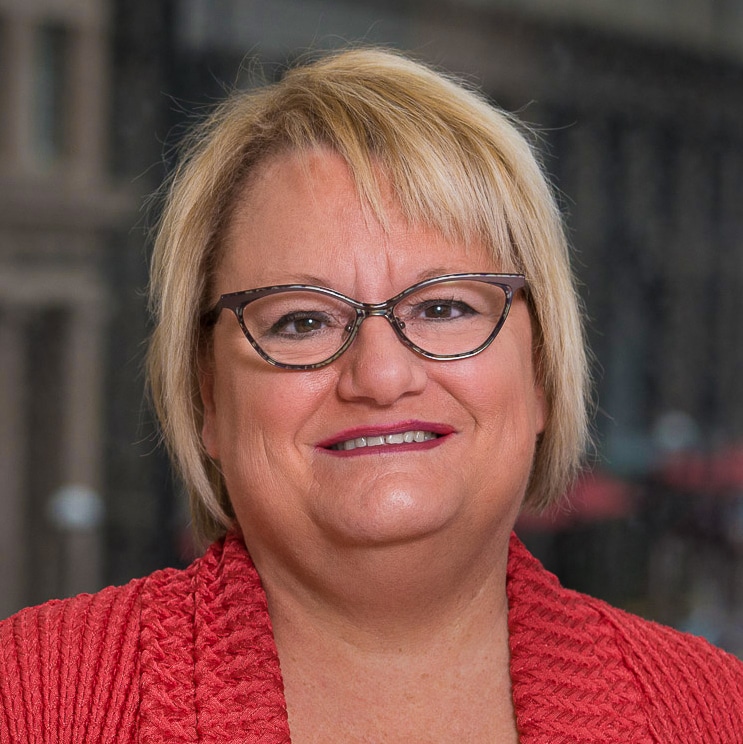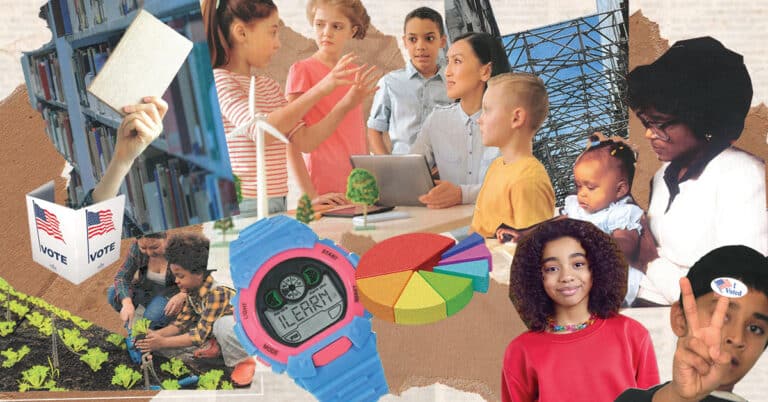This article was written by KnowledgeWorks consultant and former Senior Director of Strategic Initiatives Eric Toshalis, EdD.
At KnowledgeWorks, we spend a lot of time applying research, investigating best practices and working with leaders to co-create rich and rigorous learning environments where each learner flourishes.
We have observed classrooms and schools that inspire us with their commitments to excellence and equity, and we love supporting, celebrating and amplifying those who’ve designed and thrive within them. Likewise, we’ve seen lackluster reforms come and go, and we routinely confront the continued use of disproven and even harmful approaches.
One thing that keeps coming up for us is how to tackle tracking. We’re aware of tracking’s many indictments and we can see some of the big shifts that are needed if we’re to reverse the injustices it produces. We’ve seen how personalized, competency-based learning can center the assets of resilient and marginalized learners who are harmed most by tracking’s assumptions and practices. And unfortunately, we’ve watched leaders implement reforms in ways that preserve tracking just as often as they design systems to dismantle it. We think all roads to educational equity must eventually pass through detracking.
Looking out across the landscape of educational reform, we see many routes we could take, and a few ruts we should avoid. Our goal in this article is to name a few of both to help students, parents, educators, administrators and systems leaders chart viable paths to equitable learning environments that center the needs, interests and passions of each learner.
We think all roads to educational equity must eventually pass through detracking.
Tracking disregards major findings about how students learn best.
The research on tracking is clear. The effect of it is harm. Growth mindset posters may abound in school hallways or hang prominently in classrooms, but tracking tells low-expectancy students that no matter how hard they try they’ll still be labeled as ungifted, not honors, not advanced placement, not talented. And for the high-expectancy students, tracking sends the messages that their status was earned not by hard work or unearned privileges but by some innate quality they seem to possess over which they have no control. This flies in the face of all we now know about how students learn best.
The excuses for retaining tracking are as numerous as they are wrong. Some examples:
- Myth: “Differentiating instruction for 30 diverse students is impossible.”
Reality: It’s being done all over the country now, just like it was when we had one-room schoolhouses. Learning to differentiate is a skillset all educators can develop with proper supports and resources. - Myth: “When kids aren’t ready to progress to more sophisticated material, we need to hold them back or put them in a remediation program.”
Reality: Research demonstrates that acceleration and enrichment for all is a far better approach than stigmatizing kids through pull-out programs or making them repeat a class. And studies have shown that remediation programs seldom if ever allow students to catch up, leaving them stranded in low-resourced, low-expectation learning environments. - Myth: “Our gifted kids need special supports and separate opportunities to pursue their unique talents.”
Reality: While we believe students with well-developed skillsets and passionate interests need help channeling their energy and efforts into productive and life-enhancing experiences, each student possesses gifts and talents worth developing and all benefit from structured opportunities to hone their skills and expand their interests. Segregating students into fixed categories of “gifted” and “ungifted” does untold damage to children’s psyches (for the gifted-labelled kids too!) and creates segregated learning conditions that divide communities.
So how do we move beyond these misperceptions and rationalizations? How do we replace the logics and practices of tracking with research-based, equity-enhancing designs? We think personalized competency-based learning is one answer.
Imagine new education systems — without tracking. Learn what state and local policymakers can do to begin dismantling tracking systems.
Learn more >>
Traditionally, tracked classrooms have provided one path to achievement. The teacher designs the unit/lesson in which all students follow the same pacing and complete the same series of tasks/activities to accomplish the same academic goals. Modifications may exist if a student finishes “early” or if someone needs more time, but generally things move ahead based on the average needs of the class. The learning experience is uniform. Students are working on the same thing at the same time with their performance judged in the same way on the same date. For those students who are ready to extend their learning or those who may need to review and refine, this rigid pacing and restricted pathway is experienced as inflexible and often counter-productive. Needing and desiring adjustments that cater to their circumstances and interests, students outside the “average” may get removed and placed in either accelerated or remediated learning contexts to “meet them where they’re at.” This separation is presented as a good thing, as a way to account for differences by segregating the “struggling” from the “gifted” students. But these separate tracks aren’t benign pathways; they’re ruts. Once students get assigned to them, they never get out. That’s neither personalized nor competency-based. And it sure isn’t equitable either.
In classrooms that have shifted to implementing learner-centered practices, pathways are critical opportunities for learning, not ruts to predetermined outcomes. Veteran educator and leading reformer Ken O’Connor reminds us that, “If we don’t have pathways for learners—based on where they are going, where they currently are, and steps to advance—we are basically telling kids who are challenged: ‘Don’t bother, you’re never going to get there anyway.’” The same can be said for students who are accelerating.
When using learning pathways (not tracks), teachers:
- determine priority standards/indicators within the content
- articulate progressions needed to achieve competency
- design readiness pre-assessments to establish where a student will enter the pathway
Strategies such as flexible groupings, workshops, inquiry sessions and self-directed study become the norm. Learners have a voice in how they will access and engage with the content, which strategies they will use to progress and when and where they will show evidence of their learning, each co-designed with the teacher. In this model students are eager to ask their teachers and each other for help because doing so no longer runs the risk of branding them as a struggling learner who doesn’t belong in such a rigorous and rich learning environment. Learning pathways are unique to the student and intrinsically motivating, even when the ultimate destination of content mastery remains consistent for all learners.
In this model students are eager to ask their teachers and each other for help because doing so no longer runs the risk of branding them as a struggling learner who doesn’t belong in such a rigorous and rich learning environment.
In the Kettle Moraine School District (KMSD) in Wales, Wisconsin, one-dimensional ruts into acceleration or remediation have now become routes—personalized pathways through which kids are empowered to take ownership of their learning. Dr. Theresa Ewald, assistant superintendent of KMSD says that “the transformation to personalized, competency-based learning in KMSD helped illuminate the pathway to capstone classes for all learners. Through making the goals transparent and the possibility of evidence endless, all learners can see the path to achievement. This is the first step in true equity.”
For the high school math sequence, KMSD had moved away from singular courses such as algebra, geometry and precalculus. Instead, students simply enroll in math. Learning progressions within each math course are transparent, and through pre-assessment, students enter those progressions at their readiness level. Those who may need to refine their knowledge or review key concepts receive supports and challenges that accelerate their progression so none fall behind. A large space has been retrofitted to accommodate multiple levels of math in a block of time, with teachers providing small group instruction and progress monitoring in real time. Those who have cultivated interests or have developed expertise in a specific set of competencies are encouraged to go above and beyond requirements, creating a learning environment that is enriching for all. The paths to achievement are myriad and personalized for every learner through this innovative structure.
KMSD has been focused for over a decade on transforming their education system to meet the needs of all learners, so the reforms described here didn’t happen overnight. But the pathways they constructed make tracking obsolete.
Shifting systems away from labels and toward growth
When students tune out, whether on Zoom or in-person, we often wonder what’s wrong with them that they aren’t sufficiently interested in or motivated by what we design for them. We sometimes blame kids for not engaging, and then we spend enormous amounts of energy trying to incentivize their efforts: pizza parties, gold stars, candy, grades, praise, attention, vacuous encouragements, etc. But the problem typically isn’t the kids; it’s almost always the learning environment. And one key driver of student disengagement is tracking.
Learn about 10 drivers of student engagement, featuring steps you can take immediately to help activate engagement in remote learning settings — or any learning environment.
Read now >>
Testing, nominating, labeling, ranking, sorting and segregating students based on perceived ability makes students afraid to try. Why? Because if they do try and fail, they know it may lead to the kinds of judgments about their potential that can diminish their chance to flourish. So they hide, withdraw, resist, cheat, ridicule others, withhold work and avoid seeking help because they don’t want to broadcast that they are the ones who are struggling. And then we sometimes call them out for not “engaging.”
To further illustrate, here are some typical features in a tracked learning environment that have a negative effect on student motivation and engagement, followed by the shifts we should enact to replace them with examples from leaders who’ve done it:
Tracking vs. Personalized, Competency-Based Learning
A fixed mindset that ranks and sorts kids based on assumptions about their supposedly innate intelligence
VS
A culture of growth where learning and performance are understood to improve through effort, access, support, persistence and high expectations
Real-life example: At Westview Elementary School in Berkeley County School District, South Carolina, teachers have been implementing personalized learning pathways in grades 3-5. According to Principal Shawn Wimmer, “I’ll never go back to the time before we implemented personalized learning pathways. The evidence we have is irrefutable… How our kids talk about school [has] shifted. [They say] ‘I’m not stressed anymore because I am working at my own pace.’ [W]e are seeing [a] decrease of our risk assessments and MTSS referrals… [Our] teachers have bought into the vision of our culture of learning and inclusivity for all our kids. We have also seen an increase on our state testing with… our most challenged learners finding success.”
An instruction cycle where the teacher is at the center asking all the questions: What are my students going to learn? How are they going to learn it? How are they going to show what they have learned?
VS
A learning cycle with students at the center asking: What am I going to learn? Where am I now, what am I ready for, and how am I going to learn it? How will I share what I have learned with others? What’s my plan?
Real-life example: In Kettle Moraine School District in Wales, Wisconsin, teachers and learners engage in generative curriculum. Nowhere is it more obvious than in one of the kindergarten classes. Learners were immersed in a topic of interest they generated—all things pizza! Teachers had pulled competencies and learning progressions that aligned, and small groups were engaged in fractions. According to one student, “You can’t talk about pizza without talking about fractions!”
Traditional grading practices including averaging and 100-point scales (typically accompanied by punitive zeroes, unfair grading of formative assessments, fudgeable participation grades, fraudulent extra credit assignments, no provisions for retakes/redos/improvements, etc.)
VS
An evidence-based assessment system that supports consistent expectations of what it means to reach proficiency and design pathways of growth and progress
Real-life example: Principal Derek Bosch and his team at Cibola High School in Yuma Union School District in Yuma, Arizona, have recently implemented standards-based grading in place of the traditional assessment system the community was used to. Having a firm knowledge of their learning community’s “why” for personalized, competency-based learning, the team began their own learning journey in order to lead the shift with shared readings, opportunities to try new practices and get feedback and ample professional development supports. To support the shared vision, the team developed a set of guiding principles and expectations that set the stage for the shift. Standards-based grading has been a vital strategy to ensure every student is offered a rigorous and enriching learning pathway that inspires growth and achievement.
A curriculum-driven system focused on “coverage” (i.e., get it, repeat it and try to keep up!)
VS
A personalized, competency-based system that identifies a progression of competencies (knowledge, skills and dispositions) aligned to future-ready outcomes that are learner-centered and transparent across the learning community
Real-life example: At Batesburg Leesville High School, part of the Lexington 3 School District in Batesburg-Leesville, South Carolina, high school students are using the statewide competencies from the state’s Profile of a Graduate as success criteria in core content areas including English and mathematics. Dr. Era Roberts, assistant principal for instruction, has supported the shift, citing an increased focus on future-ready outcomes and learner agency, regardless of students’ post-secondary plans. She explains that “action-packed skills are the drivers for engagement with any subject matter. By using the South Carolina Profile of the Graduate Competencies, we have clear descriptions of how those skills manifest at a variety of levels. Crafting tasks and assessments around these goals provides an entry point for all learners in a dynamic way. Using skills-focused pre-assessments we can then plan pathways and build knowledge from a strengths-based perspective.”
The ruts of tracking on which failure, stagnation, and disempowerment are rampant
VS
The routes of personalized, competency-based learning where student growth and success are assured and agency is enhanced
Real-life example: Providing students with individualized pathways to success that are characterized by transparent measures of competency and ample opportunities to meet or exceed expectations keeps them engaged in learning and striving for excellence. Such routes to achievement are markedly different than the ruts of tracking because they offer personalized pathways students claim as their own, alongside peers who are taking different paths to the same shared outcomes. At Batesburg Leesville Middle School in South Carolina, such routes are commonplace. In Mrs. Rose’s math classes, for example, readiness pre-assessments provide learners with a look at what they know and what they are ready to learn next. Instead of focusing on the gaps in student knowledge or skills and separating them into stigmatizing ability groups, her students focus on a progression of learning, co-setting goals and and choosing pathways to achieve them and monitoring their progress to look for opportunities for support, acceleration and enrichment.
Personalized, competency-based learning and tracking: You can’t have both.
Personalized, competency-based learning is incompatible with tracking. We cannot personalize learning when we lump students into supposedly homogenous groups based on biased, discriminatory and fixed judgements about their ability, and then try to “teach to the middle.” And we cannot establish academic competencies and move all students toward demonstrations of excellence when we send certain subsets of learners to be remediated in dead-end classes while others have exclusive opportunities to be enriched and accelerated. Pacing, pathways and progressions all can and should be personalized without resorting to tracking regimes that stamp, segregate and discriminate learners.
So, what can I do right now?
- Look at different student pathways through courses and content levels in your neighborhood elementary, middle or high school. Who gets the most opportunities for enrichment? Where are the gates that restrict inclusion? How does one get identified for acceleration or remediation, and how are those opportunities supplied? What criteria are gatekeepers using? Do students who’ve been identified for remediation ever rise out of that track? What is the rationale that educators supply for labeling and separating students based on perceived ability?
- What patterns do you notice in (dis)engagement and discipline at your school? Do they align with the lowest tracked classes? If so, what theories do you have for this? What explanations do school and district officials supply?
- Ask a teacher, administrator or district official what they plan to do to integrate personalized, competency-based learning in their work, or if they’re already building these kinds of learning environments, how it’s going. What ideas do they have? What barriers do they note? To what extent do they identify tracking as a feature to either dismantle or reinforce?
Don’t miss articles like this. Sign up to receive our email newsletter for the latest resources supporting the kinds of student-centered learning experiences we want for all learners.








